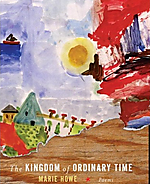(from) The Spell by Marie Howe
Every day when I pick up my four-year-old daughter from preschool she climbs into her back booster seat and says, Mom–tell me your story. And almost every day I tell her: I dropped you off, I taught my class I ate a tuna fish sandwich, wrote e-mails, returned phone calls, talked with students and then I came to pick you up. And almost every day I think, My God, is that what I did? These lines are from the middle of Ms. Howe’s poem. They offer a certain intimacy, one that I find appealing. It strikes me that a poet can use language to hold a reader at a distance–can perform acrobatic feats with language—look—be amazed—or a poet can use language to invite a reader in a bit—into a particular moment, or, say, into the poem itself. And this inviting, it can be terribly deft and skillful. Achieving a kind of naturalness of tone—a sense of conversation—but, at the same time, it’s not literal conversation. It’s a distillation of conversation—an essence of conversation. Still, it has the sound of conversation, the cadence. Robert Frost does this. William Carlos Williams sometimes. Deft but not showy. Ordinary in the way a Shaker chair is ordinary? The poem doesn’t actually begin with the “I” in the car with the young child. The poem begins when the neighbor, Pablo, another four-year-old, has lost his wand and he’s trying to perform spells with his finger but that’s not working so well, and his mother tries to give him a chopstick to use, but—nope—that’s not going to do it. (A poet these days in Pablo’s predicament then? Trying to perform spells without a wand? Trying to weave magic with only the most ordinary language?) The poem continues with the daughter in the car. It locates itself in a particular day—yesterday. The daughter is not content with the mother’s account of her day–the sandwich and the e-mails. She wants to know “the whole thing.” And the mother answers. It’s one of the surprises of the poem, that turn.And I said, ok. I feel a little sad. And I said, ok. I feel a little sad. And she said, Tell me the whole thing Mom. And I said, ok Elise died Oh. The poem continues: Elise is dead and the world feels weary and brokenhearted. And she said, Tell me the whole thing Mom. And I said, in the dream last night I felt my life building up around me and when I stepped forward and away from it and turned around I saw a high and frozen crested wave. I love how this poem descends in layers. Goes beneath the ordinary. To a dream—this image of a frozen crested wave. The daughter continues to ask for more. New images are unearthed. A goose. A winged serpent. Still, the daughter is relentless. “Tell me the whole story.” And I said, Elise is dead, and all the frozen tears are mine of course and if that wave broke it might wash my life clear and I might begin again from now and from here. Ah. if that wave broke. . . An image, I think, worth going down through layers for. And one of the many things I like about this poem is the way it seems to...
read more

